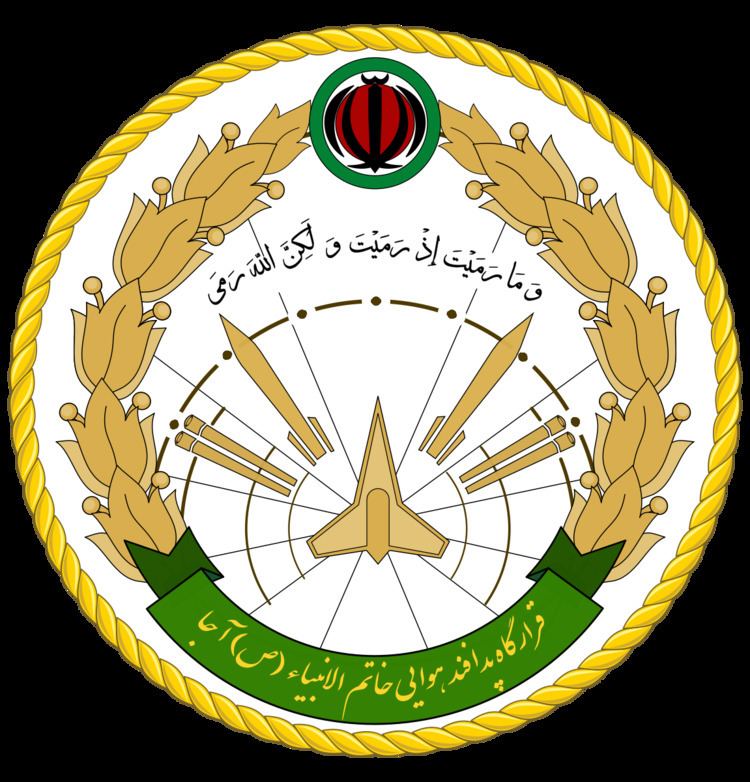Type Air defence | Branch Artesh Size 15,000 (estimate) | |
 | ||
Active 1933–1954 (Part of Ground Force)1954–2008 (Part of Air Force)2008–Present (As Separate Force) | ||
The Islamic Republic of Iran Khatam al-Anbia Air Defense Base (Persian: قرارگاه پدافند هوایی خاتم الانبياء ارتش جمهوری اسلامی ایران) is a branch split from IRIAF and part of Islamic Republic of Iran Army. It controls all of Iran's military land-based air defense. It is currently commanded by Brigadier General Farzad Esmaili.
Contents
History
As of 1996 Iranian Air Defence forces included about 18,000 military personnel. The tradition of aircraft-based air defense, derived from the US-trained Air Force from before the 1978-79 revolution, was giving way to an expanding arsenal of ground-based air defense missile systems. Still, Iran was at the time unable to construct a nationwide, integrated air defense network, and continued to rely on point defense of key locations with surface-to-air missile batteries.
The bulk of Iran's Air Force Air Defence holdings by the mid-1990s revolved around 30 Improved HAWK fire units (12 battalions/150+ launchers), 45-60 SA-2 and HQ-2J/23 (CSA-1 Chinese equivalents of the SA-2) launchers. Also available were some 30 Rapier and 15 Tigercat SAM launchers. There are reports of the transfer of SA-6 launchers to Iran from Russia in 1995/1996.In 1997 the Iranian Air Defense forces declared the Almaz S-200 Angara (SA-5 'Gammon') low-to high-altitude surface-to-air missile (SAM) operational.
In December 2005 Iran entered into a contract to purchase 29 TOR-M1 (SA-15 Gauntlet) mobile surface-to-air missile defense systems from Russia worth more than US$700 million (EUR 600 million).
Between 1998 and 2002 Iran imported approximately 6 JY-14 surveillance radars from the China National Electronics Import-Export Corporation. The radar can detect targets up to 300 km away and is now part of Iran's air defense system.
On 1 September 2008 it was reported that Russia may proceed with plans to sell advanced S-300 air defence systems to Iran under a secret contract believed to have been signed in 2005. On 22 September 2010 Russian President Dmitry Medvedev signed a decree banning the sale of the S-300 and other military equipment to Iran. The sale was canceled because of United Nations Security Council Resolution 1929 sanctions on Iran. On 10 November 2010 Iran announced that it had developed a version of the S-300 missile.
Iranian land forces have a total of some 1,700 anti-aircraft guns including 14.5mm ZPU-2/-4, 23mm ZSU-23-4, 23mm ZU-23s, 37mm type 55s, 57mm ZSU-57-2 and 100mm KS-19s.Iran also had 100-180 Bofors L/70 40mm guns and modest numbers of Skygaurd 35mm twin anti-aircraft guns.It largest holding consisted of ZU-23s(which it can manufacture).
Recently Iran has built several new anti-aircraft guns including Samavat 35mm Anti-Aircraft Guns, Sa'ir 100mm Anti-Aircraft Guns (Upgraded automatic version of KS-19) and the Mesbah 1 air defense system.
On 21 August 2012 the Iranian military started construction of its largest air defense base in the city of Abadeh in the Southern Fars province. The air defense base is due to be built at the cost of $300 million and will have 6,000 personnel available for a large array of duties, including educational ones. Days later, the defense ministry also announced plans to develop Bavar 373, a new long-range air-defense system, by March 21, 2013.
Spellout, Peace Ruby and Peace Net
These three programs were instituted by the United States, (pre revolution), to improve/upgrade the air-defence system of Iran. As well as air defence radars the network was linked using microwave LOS and troposcatter communications networks.
